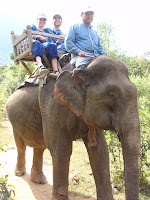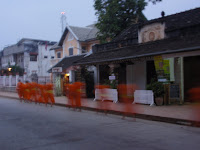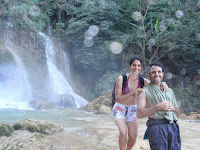One of Lao's most famous eco-tourism adventures is called a Mahoot. It is a chance to get really close to one of mother nature's largest animals, the elephant. We signed up for a two-day, one-night mahoot in which we would ride the elephants, learn their commands, and bathe them.
On day one, they picked us up from our hotel and we drove for about a half hour outside the city to the elephant camp. Once there, we found our house on stilts which would be our "hotel room" for the night. On the beds were our blue denim uniforms for riding.
These uniforms help the elephants identify their masters. We wasted no time and walked over to the elephant encampment where they keep and feed the elephants. We introduced ourselves to a few friendly faces:
Our first experience riding on the elephants was on a wooden seat on the elephant's back. Each of us had our own elephant and guide with us. We learned that the elephants eat more than 200 pounds of food every day and spend about 18-20 hours eating. It was amazing to see the elephants pick up whole pineapples and stick them in their mouths to bite off the fruit and toss the green stems. They also can devour entire foot-long sections of sugarcane. Their bodies are covered with thick prickly black hair, but the skin behind their big flapping ears is nice and smooth. The elephants also have long eyelashes and they are constantly batting their eyes. Each of the elephants at this camp wears a bamboo bell around their neck, which produces a rhythmic song as they trod through the forest. Most of the elephants that tourists ride in S.E. Asia are females due to their more calm demeanor.
The next step was to get down and dirty. We rode directly on the neck of the elephant. At this point, we used the commands we learned in Lao to direct the animal in whichever way we needed. "Pai Pai" meant "go straight." "Pai Sai" was to let the elephant know he/she should walk left, while "Pai Qua" was to the right. After all this training, the elephants needed to cool down, so we rode to the river and helped give them a bath. The guides were all too thoughtful. They appeared at first to be eagerly splashing the elephants, but were in reality trying their hardest to get us all wet. Despite this, we had a great time as evidenced by this video:
To cap off the day, our guide took us down to the edge of a river where we climbed aboard a long-tail boat and went upstream a couple of miles. From there we floated downstream atop innertubes and watched the world go by.
After a long day of riding elephants and tubing down the river, it was time for a refreshing cold shower in our outdoor bathroom in the back of our wooden house. While it was enclosed to shut peeping eyes out, we could shower under the clear blue skies. We left our denims to dry on the porch and went off to dine alfresco on some excellent vegetarian curry, vegetables, and rice. In the mix of vegetables, we found an elephant-shaped mushroom, which seemed pleasantly appropriate at the time.
We then returned to our cabin for some well-deserved sleep, knowing we'd be up early to once again bathe the elephants.
The next morning, other than it being early and very cold, we had to dress back in our uniforms. However, as it was cold the day before, they had not dried. So there we were at 6:30am in our wet denim suits going to ride the elephants into the river for their morning bath. The sun eventually came up and we dried off and warmed up.
Finally, it was time to say goodbye to our new friends and head off to see one of Lao's many waterfalls. We returned to the longtail boat and sped up the river to swim under the falls. In contrast to the previous falls we visited, these falls were much smaller, but you could get right underneath them for a nice head massage. Our guide was an excellent photographer for us while we got wet and helped us document our adventure.

Once back in town, we decided to return to our favorite sauna. We steamed for a couple of hours and then got pampered further with an oil massage. To cap off the night, we ate dinner at a Lao BBQ restaurant that served "falang-sized" portions. Falang is a term used by the locals to describe any foreigner. It comes from the Lao word for French people. Thus, our extra-large portion was more than you would normally find in a local Laotian restaurant. Despite our waiter's insistence that we get a portion big enough for 2, we ordered the dish for one. The waiter brought out a small habachi-like BBQ to the table where we cooked our food before our very eyes.
To see more of our wonderful photos, please go to: grossmintblog.shutterfly.com












